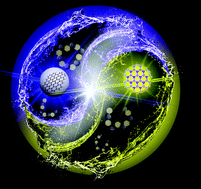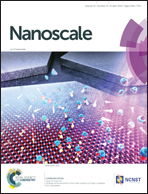Carbon-ZnO alternating quantum dot chains: electrostatic adsorption assembly and white light-emitting device application†
Abstract
Aggregation-induced quenching (ACQ) in carbon nanodots (CNDs) impede their applications in solid devices. Herein, the concept of alternating quantum dot (QD) chains was proposed to overcome the common issue of fluorescence quenching in CNDs; in this study, CNDs and ZnO QDs were interlinked to form carbon-ZnO alternating quantum dot chains (CZA-QDCs), which overcame the ACQ of CNDs and hence ensured efficient full-spectrum fluorescence for white light-emitting devices (WLEDs) without excessive blue emission. Under the excitation of 365 nm lines, white emission resulting from the combination of blue emission from the CNDs and yellow emission from the ZnO QDs has been achieved from these powders. The quantum efficiency of the CZA-QDC powders can reach 49% and remain stable for two months. By coating the powders onto an ultraviolet chip as phosphors, WLEDs with a luminous efficiency of 20.1 lm W−1, color coordinate of (0.30, 0.35), correlated color temperature of 5205 K, and a color rendering index of 84 have been fabricated. Due to the relatively high abundance and eco-friendly characteristics of both carbon and ZnO, the results reported herein may provide a promising alternative to fluorescent phosphors that are widely used in WLEDs.



 Please wait while we load your content...
Please wait while we load your content...